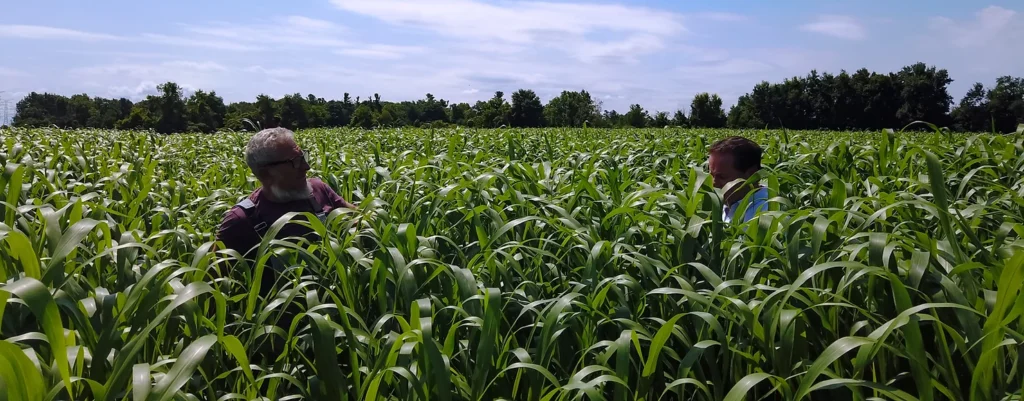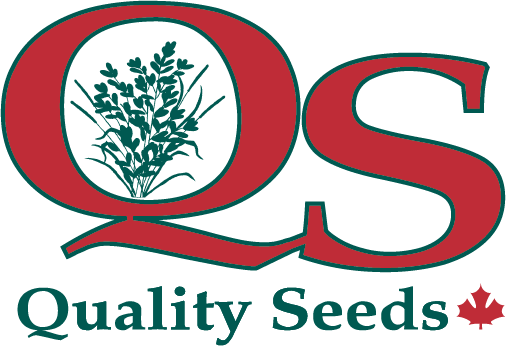Sudangrass & Sorghum-Sudangrass Forage Options

Sudangrass and sorghum-sudangrass are warm-season annual grasses from the sorghum family. They are grown in the summer and have the potential to provide high yields of palatable, high quality forage when properly managed. Although rainfall is necessary for optimal growth, they are very drought tolerant and respond well to hot summer weather. They are very frost sensitive, both in the spring as seedlings, as well as in the fall when frost will kill them, preventing any further growth.
As part of a rotation, sudangrass and sorghum sudangrass can provide significant yields of quality forage. They can also fit well as a double crop forage option after winter cereal (triticale, rye) forage harvest. Also, terminating winter injured, low yielding alfalfa fields after first-cut and planting to sorghum-sudangrass or sudangrass can provide emergency forage that will be needed to make up the shortfall. They can also be planted into unseeded soybean and corn acres during a wet year in June or July to provide additional forage.
Sudangrass Or Sorghum-Sudangrass?
While sorghum-sudangrass possibly has higher yield potential, sudangrass is leafier with much finer stems, which provides higher forage quality. New BMR (brown mid-rib) types of both species are available, which provide low-lignin, higher fibre digestibility (NDFD) for improved forage quality. Yield expectations under optimal weather conditions, management, and timely seeding are 3 – 5 tonnes or more of dry matter per acre (typically 1.5 – 2 tonnes per cut).
Harvested at the correct stage with good fertility, these crops, particularly BMR types, have high NDFD 30 (fibre digestibility) levels of 60 – 70%, crude protein levels of 15 – 18% and RFQ levels of 150 – 200. For dairy quality feed, BMR sudangrass is preferred. BMR sudangrass varieties exclusive to Quality Seeds include SS2 and HayKing II (Hi-Gest®). Using common seed rather than these known varieties is much less predictable in performance. Do not confuse single-cut sorghums with these multi-cuts because management, harvest and feed quality goals are different.
Seeding
Sudangrass and sorghum-sudangrass require a soil temperature of at least 15.5 – 18°C (60 – 65°F) for optimal germination, rapid emergence and growth. This typically occurs the last week of May or early-June. They do not perform well when seeded into cold soils. A cold rain after seeding can result in chilling injury. A late spring frost after planting can kill or stunt the new stand. While they have very good drought tolerance once established, some rainfall is necessary for germination and early growth.
Sudangrass and sorghum-sudan are often planted after winter triticale and fall rye forage crop harvest, or after a low yielding alfalfa stand after first-cut. A burndown and some light tillage (a prepared seedbed) should be done before seeding. Sudangrass and sorghum-sudan seedlings are not very competitive against existing growth, and root growth is inhibited in hard soils, particularly in heavier soil types. No-tilling into an existing stand without a burndown or tillage is usually disappointing. An application of glyphosate, or a “stale seedbed” system (tillage followed by harrowing after weed seedlings emerge) before seeding should be done to prevent excessive weed competition (particularly grasses) to sorghum seedlings. When following an unproductive alfalfa first-cut, a pre-harvest application of glyphosate can enable an earlier seeding.
Proper seeding depth and seed-to-soil contact is important. Suggested seeding depth for sudangrass is ½ – ¾ inch and ¾ – 1 inch for sorghum-sudangrass. The seedbed should be firm, and well packed after seeding. Seeds planted too deep, or planted too shallow by broadcasting, frequently result in seeding failures. Using a no-till drill is best for proper seed placement. A suggested seeding rate for sudangrass is 25 – 30 lbs/ac. A suggested seeding rate for sorghum-sudangrass is sometimes 40 – 50 lbs/ac, but a seeding rate of up to 60 lb/acre can provide a stem that is finer and less coarse, and also provides greater competition against weeds.
Fertility
Nitrogen (N) and sulphate (S) are essential for high yields and protein content. A pale green colour with reduced growth can indicate N and S deficiency. A suggested rule of thumb for forage grass species is 45 lbs/acre of actual N for each ton of expected dry matter yield. For example, if you were expecting a seasonal 4 ton dry matter yield of sudangrass over 3 cuts, that would be a total of 180 lbs of N, or an average of 60 lbs per cut. A 2-cut yield of 3 tons would require 135 lbs/ac.
While some prefer a single N application cultivated in before seeding, split applications of nitrogen before seeding and again after 1st-cut can provide greater N utilization and minimizes environmental loss. A split application of nitrogen can be applied before seeding at a rate of 110 – 120 lbs/acre of actual N, and an additional 50 – 60 lb/acre broadcast after first cut, depending on yield potential. If alfalfa was the previous crop, or if manure was applied, the nitrogen credits should be considered and accounted for.
If manure has not been applied (manure contains sulphur), consider sulphur (S) requirements by including sulphate to the N application to improve yields and % CP. A suggested amount is 1 lb of S for every 10 lbs of N.
If liquid manure is to be applied, it should preferably be done before planting, or immediately after harvest to minimize damage to regrowth (within 2 days) and N rates should be adjusted accordingly. There is some susceptibility to heavy traffic damage. P and K removal rates are similar to other grass forage species – approximately 12 – 14 lbs P2O5 and 50 -55 lbs K2O per ton of dry matter yield.
Growth & Harvest
After seeding, seedlings should emerge within a week given warm soils and adequate moisture. Dry weather can delay emergence. Growth of these species is initially modest, but accelerates very rapidly at about the 7 – 8 leaf stage. Once established at this stage, rapid growth usually out-competes most weeds, and herbicide weed control is not necessary. However, if broadleaf weed pressure is heavy at the seedling stage, herbicide application may be considered. Refer to OMAFRA Publication 75, Guide To Weed Control www.omafra.gov.on.ca/english/crops/pub75/pub75A/pub75A.pdf,
p.186. Herbicides include bromoxynil (Pardner) and prosulfuron (Peak + Assist).
For dairy cow, high quality feed, first-cut typically occurs 40 – 45 days after planting, before the “head emergence” stage, while the crop is 36 – 45 inches in height. Nutrient quality drops quickly and dramatically at heading. A general rule-of-thumb is 45 days or 45 inches, whichever comes first. Regrowth is rapid, and a second-cut is usually ready 30 – 35 days later. These species are harvested as haylage or baleage, but because their stems contain high moisture levels, they cannot be dried for hay. Yield potential for high quality sudangrass is typically 1.5 – 2 tonnes/acre of dry matter per cutting. Delayed harvest will increase yield but significantly reduce forage quality.
A high cutting height of at least 4 inches (5 – 6 inches preferred), leaves 2 growth nodes that are required for faster, more vigorous regrowth. Wide swaths and proper roll conditioning (crimping) enables faster wilting of stems to proper ensiling moisture. Adequate packing for efficient fermentation can sometimes be an issue with coarser stemmed sorghum-sudangrass.
Because of its tillering ability and continuous fibrous root growth, 2nd cut yields often exceed 1st cut. While 2 cuts are common, with timely seeding and aggressive cutting schedules, and without an early frost, 3 cuttings in a season are possible. With cooler weather, growth in September is much slower. Harvest before the risk of frost to avoid quality loss issues and potential nitrate and prussic acid risks.
Nitrates & Prussic Acid
Ideally, the final cut of the season should be taken before frost to optimize forage quality and eliminate potential prussic acid risk. Prussic acid toxicity after frost can be a potential issue with sorghums when grazed, but this is usually not an issue when sudangrass is harvested as haylage and it is fully fermented.
Nitrate toxicity is also possible with warm-season annual grasses, particularly if harvested following a drought-ending rain or frost, but again, this is also more of an issue with pasture and green-chop. When high nitrates occur, fermentation dissipates the nitrates as nitrogen dioxide (silo gas).
For information on how to manage to risk of prussic acid and nitrate poisoning, particularly in green chop and pasture situations, refer to “Forage Sorghum-Sudangrass” at www.omafra.gov.on.ca/english/crops/facts/98-043.htm.
Using BMR Sudangrass As A Companion Crop With Forage Underseedings
This has recently been done very successfully by farmers in Ontario and Quebec using specific management practises. Although there is more risk during a severe summer drought, sudangrass appears to be less competitive to early growth of alfalfa-grass seedlings than oat-peas, and then sudangrass canopies over to shade and protect them.
Suggested management practises to consider when underseeding to BMR sudangrass are as follows:
- Glyphosate burndown and prepared seedbed with tillage before planting essential
- 20 lbs/ac sudangrass and 18-20 lbs/ac alfalfa-grass blended together, seeded with a no-till drill through the cereal box at ½ inch seeding depth (maximum), seedbed well packed and firm
- Limit nitrogen to 120 lbs per acre cultivated in before seeding
- Do not apply manure after planting or harvest – very susceptible to traffic damage
- Harvest the last cut either before September, or just before frost, avoiding the Critical Fall Harvest Period




Figures 1 & 2 – HayKing II BMR sudangrass planted May 28th, Listowel area. Pictured at 50 days. Same field showing underseeded alfalfa-grass.


Figure 3 – HayKing II BMR sudangrass planted at 35 lbs/ac on June 18th. Pictured at 40 days. Elmira area.


Figure 4 – HayKing II BMR sudangrass 45 days after planting. Summitholm Holsteins, Ancaster. July 31st.


Figure 5 – SS2 BMR sudangrass planted July 9th, harvested August 22nd, Cannington.


Figure 6 – SS2 BMR sudangrass planted July 25th, harvested September 13th. Prince Edward County.
